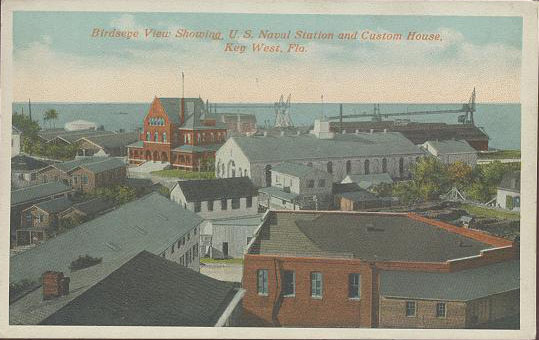
|
|---|
According to the Federal census taken 16 August 1860, David was the only Ellis living in Monroe County, Florida. He was rooming with two men, John Wilson, age 43 from Sweden, and Antonio Hachetto, age 26 from Italy.1
All three men are listed as mariners. They lived in the last residence before the U. S. Garrison, as it was referred to on the census report. Of the 73 individuals living in the 19 dwellings before the garrison, 71 including David, were mariners. With one exception, they were not related to the men they were boarding with. The one exception was a family, all male, that ranged in age from 8 to 59. Everyone in that family, except the 59 year old, was a mariner. There were no women living in the neighborhood. The men came from every state along the eastern seaboard, the Bahamas, England, Spain, Germany, Portugal, the Canary Islands, Ireland and Scotland predominately. The ages of the sailors ranged from 8 to 45 with most of the men being in their early 20s.2
Key West can be said to have pioneered cultural diversity! In other parts of Key West there were mariners living with their families. According to the 1860 census “Key West . . . was home to 2,241 whites and 435 slaves. The city also included 156 free blacks who owned property worth over $12,000. Key West’s free black population accounted for virtually the entire free black population of South Florida in 1860, and it similarly accounted for almost one-ninth of Florida’s total free black population.”3

|
|---|
Here is that story . . .
Key West was the only southern city to remain in Union hands throughout the Civil War. This was possible due to the geographic location of Key West and also to the independent actions of Captain Brannan. As with all history, events began years in advance building up to the Civil War.
An editorial written in 1832 in a Key West newspaper eerily portends actions to come.
“We have always thought that the value of our Union consisted in affording equal rights and equal protection to every citizen; when, therefore, its objects are so perverted as to become a means of impoverishment to one section, whilst it aggrandizes another, when it becomes necessary to sacrifice one portion of the States for the good of the rest, the Union has lost its value to us; and we are bound, by a recurrence to first principles, to maintain our rights and defend our lives and property. If we are oppressed, it is a matter of perfect indifference whether that oppression be inflicted by a foreign power or our next door neighbor. Upon the same principle we are compelled to resist both – ‘even unto death.’”5
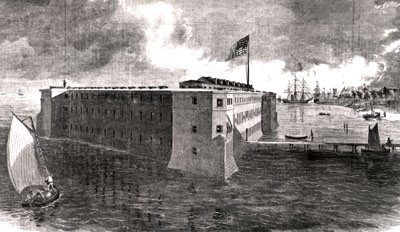
|
|---|
The construction of Fort Taylor began in 1845. It would be finished in 1866. It was located on a shoal of 63 acres just outside the city of Key West. “Actually the fort was built of reddish brick, and the shape was trapezoid, or a hexagon cut in half, with the long side thus formed facing the shore and connected to it by the causeway, the whole structure surrounded by water. The five foot thick walls rose almost 50 feet above the water, with a ground floor and two stories of gun rooms. A desalination plant for the production of domestic water supplies had been in operation as early as 1862.”6
It was situated such that it could guard the harbor and monitor approaching ships. Whoever commanded the fort, controlled Key West.
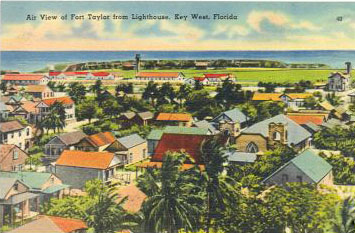
|
|---|
As events heated up, the prominent citizens of Key West were pro-Southern.7 In December of 1860, a meeting was held to elect delegates to attend the state convention to determine whether Florida would remain in the Union. “On December 11, the day before this meeting was held, Captain James M. Brannan of the First Artillery, who was stationed at the barracks at Key West, applied to the adjutant general at Washington for instructions whether he should ‘endeavor at all hazards to prevent Fort Taylor from being taken or allow the State authorities to have possession without any resistance on the part of his command.”8 He did not receive his reply until January 26,9 several weeks too late. Florida withdrew from the Union on January 10, 1861. The Ordinance of Secession was signed the next day.
“Before Florida’s secession, only sixteen Union engineers were stationed at Fort Taylor to repair its defensive structure. In response to ‘the reported seizure of various neighboring forts and arsenals,’ Captain Edward B. Hunt, the commander of Fort Taylor, urged Captain Brannan on January 12 ‘to assume the military command of Fort Taylor.’ With the fort’s structure nearly completed, Hunt reported that the security of the fort would possibly be endangered because many of his men were due to be discharged.
Brannan recognized the importance of Fort Taylor for the Union. He also realized the islanders’ capability of seizing and holding the fort; therefore, on the evening of January 13, silently and without authorization, Brannan moved his command of forty-four men into the fort.”10
When the citizens awoke the next morning, Fort Taylor was firmly controlled by the Union Army. Although no one would know it for several years, that was the beginning and the end of any battles in Key West. “Capt. Brannan was ‘appointed Brigadier General of Volunteers Sept. 20, 1861,’ and ordered north.”11
According to his obituary, “Capt. Ellis had been in the lighthouse service since 1868, and previous to that date he had served the United States government in capacities appertaining to his calling for twenty-five years.”12
(emphasis added by author) There are no records that indicate the David Ellis I am writing about served in either the Union or Confederate armies or navies.13
However, during the Civil War there were transport and personnel ships that ran between Key West and Fort Jefferson. They were government owned but manned by civilians. I think there is convincing evidence that David Ellis was in fact the captain of the Schooner Torgugas, which sailed between Key West and Fort Jefferson. This is the evidence.
The Dry Tortugas is a series of small islands approximately 70 miles west of Key West. They form the shipping channel for the Atlantic, the Gulf of Mexico and the Caribbean. Tortugas, which is Spanish for turtles, was named by Ponce de Leon. The series of islands that make up the Tortugas look like large turtle shells from a distance, also, there is an abundance of large turtles in the waters around the islands which for many a sailor and soldier was their only source of fresh meat. The word “dry” was added to the navigation charts to indicate that there was no fresh water available.
In 1846, the U.S. began building a fort on the Garden Island in the Dry Tortugas as part of its build up of coastal forts. The island already housed a 65-foot lighthouse. The fort was built around it. It covered almost the entire 25-acre island. The large masonry fort was surrounded by a moat. During the Civil War it was used as a fueling station, supply depot and Federal prison.
“A description of the fort while it was being used as a Federal prison indicates the difficulties involved in an escape attempt: Fort Jefferson is an imposing structure. . . . The walls rise from the very sea, and are only protected from it by a low wall, which incloses a moat sixty feet in width. A heavy cornice orcastellated battlement gives a noble and picturesque feature; and at each bastion the round towers furnish fine stairways of granite, and are surmounted with pointed roofs, which with the modern traverse magazines on the top of the parapet, some sixty feet from the base, give more the effect of the ancient castle than is seen in other works of this country. The sallyport is the only entrance; and here is a drawbridge and heavy gates, over which are cells where the conspirators are incarcerated. Since the establishment of the military prison here it has been necessary to maintain a heavy guard. . . . There were man-eating sharks in the moat. One, called ‘provost marshall’ was a particular deterrent to escape attempts.”14
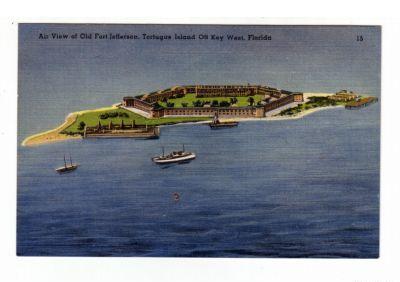
Air view of Ft. Jefferson
“. . . in 1863 personnel strength, including garrison, engineers, prisoners, and others, probably ranged between a low of 600 and a high of 1200 or more. During other periods, the fort may have held close to 2000 members of the garrison, workmen and prisoners.”15
Both Fort Jefferson and Fort Taylor expected attacks from southern sympathizers. One feeble attempt was made on Fort Jefferson.
“Friday, January 18, 1861 Capt. Brannan had reported that ‘there were no troops or guns (at Fort Jefferson) til the 18th of Jany. . . . Maj. Arnold reported arriving at Fort Jefferson on Friday (January 18) ‘garrisoned and assumed command of the post . . . four commissioned officers and sixty-two enlisted men."16
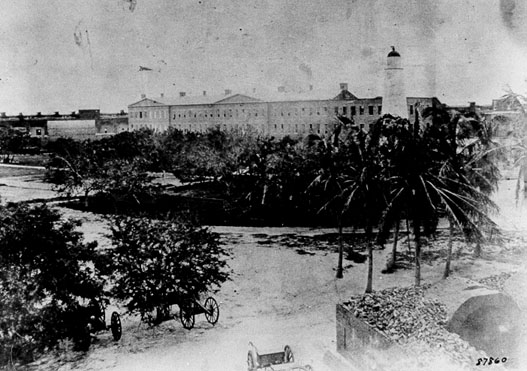
|
|---|
“If this company had been three days later, the fort would have been occupied by Floridians. It is known that the rebels had their eyes upon those powerful forts, which govern the commerce of the Mexican Gulf as Gibraltar and Malta govern that of the Mediterranean. With forts Jefferson and Taylor, the rebels might have purchased an early European recognition.”17
On 6 September 1861, Maj. French of the US Army issued Order No. 82 which required all male citizens of Key West to take an Oath of Allegiance.18
Anyone leaving Key West or the Tortugas had to have the permission of the ranking military officer.
There are two mentions of Captain Ellis in the diary kept by Emily Holder, wife of the assistant surgeon at Fort Jefferson.
“Monday, November 17, 1862Their return trip is recorded “Sunday, November 23, 1862
The chaplain of the 90th New York was still at the Tortugas, but was preparing to leave on the Tortugas with five of the women from the fort.All the command saw us off, our husbands waving their handkerchiefs from the ramparts as long as we could see them, while the six children stood in a disconsolate row. We had a delightful trip with a fair wind, leaving at five in the afternoon. That evening Capt. Ellis brought us a box, saying he thought it belonged to us. It was directed “To the Merry Wives of Tortugas,” and upon opening it, was found to contain some delicacies from the sutler, packed by our husbands.”19
Returning with the chaplain for a short visit and vacation, were the five women who had been in residence at the Tortugas. Their husbands had ‘promised to be responsible for the safety of the children, for two of the ladies would have small ones to care for’ back at Fort Jefferson. Capt. Ellis and the Tortugas brought them to Key West.”20
Found tucking into one of David’s log books, was a yellowing, faded, water-stained, permission slip.21 It reads:
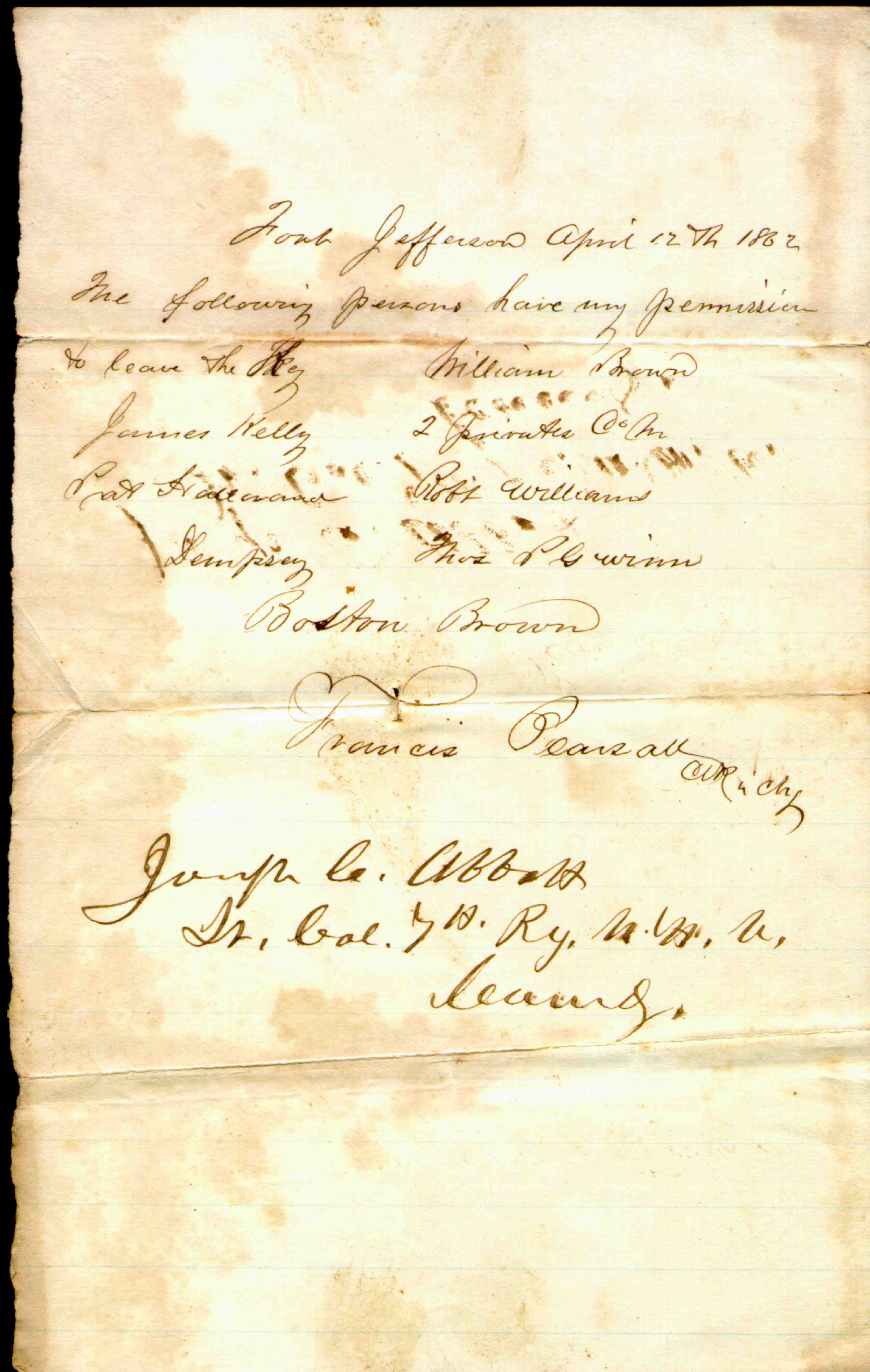
| James Kelly | William Brown |
|---|---|
| [Illegible] | [Illegible] |
| Robt. Williams | |
| Dempsey | Thos Pl_____ |
| Boston Brown | |
| Francis Pearsall – clk. in chrg (Signed) Joseph C. Abbott Lt. Col. 7th Ry. N. H. V. (7th Regiment, New Hampshire Volunteers) |
|
It is interesting that this note was deemed worthy to be kept. One of David’s children, using the back of one of David’s log books as a copy book, copied the beginning of the permission slip. I wonder if David was telling the story of an adventure surrounding this permission. Apparently it was of some significance.
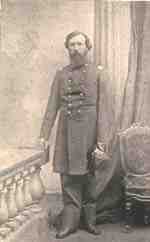
|
|---|
| http://www.library.miami.edu/archives/shedd/abbott.htm |
There are two references to the Schooner Tortugas made by members of the 7th Regiment of the New Hampshire Volunteers.
Calvin Shedd, a member of the Seventh Regiment, New Hampshire Volunteers, wrote a series of 53 letters to his wife and children. He was stationed at Fort Jefferson with Col. Abbott. In one of his letters he mentions “Sunday 20th Last night the Schooner Tortugas arrived from Key West with news of a great fight on the Mississippi . . .”22
In the regimental history, written by Henry F. W. Little, regimental historian, we read, “The men will remember that most of our mail came on the schooners “Tortugas” and “Nonpareil,” which kept up a constant communication with Key West at intervals of two or three days . . .”23
David Ellis was in Key West during the Civil War working as a mariner for the U. S. government. He knew Col. Abbott and the 7th New Hampshire regiment. The Regiment had regular contact with the Schooner Tortugas. The Tortugas was piloted by Captain Ellis. Thus this chapter has come full circle.